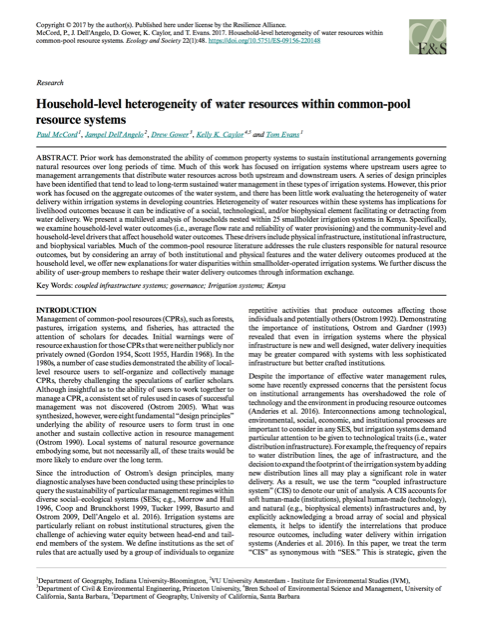Household-level heterogeneity of water resources within common-pool resource systems

McCord, P., Dell’Angelo, J., Gower, D., Caylor, K.K., Evans. T. (2017) “Household-level heterogeneity of water resources within common-pool resource systems”, Ecology and Society, doi:10.5751/ ES-09156-220148.
Abstract: Prior work has demonstrated the ability of common property systems to sustain institutional arrangements governing natural resources over long periods of time. Much of this work has focused on irrigation systems where upstream users agree to management arrangements that distribute water resources across both upstream and downstream users. A series of design principles have been identified that tend to lead to long-term sustained water management in these types of irrigation systems. However, this prior work has focused on the aggregate outcomes of the water system, and there has been little work evaluating the heterogeneity of water delivery within irrigation systems in developing countries. Heterogeneity of water resources within these systems has implications for livelihood outcomes because it can be indicative of a social, technological, and/or biophysical element facilitating or detracting from water delivery. We present a multilevel analysis of households nested within 25 smallholder irrigation systems in Kenya. Specifically, we examine household-level water outcomes (i.e., average flow rate and reliability of water provisioning) and the community-level and household-level drivers that affect household water outcomes. These drivers include physical infrastructure, institutional infrastructure, and biophysical variables. Much of the common-pool resource literature addresses the rule clusters responsible for natural resource outcomes, but by considering an array of both institutional and physical features and the water delivery outcomes produced at the household level, we offer new explanations for water disparities within smallholder-operated irrigation systems. We further discuss the ability of user-group members to reshape their water delivery outcomes through information exchange.
